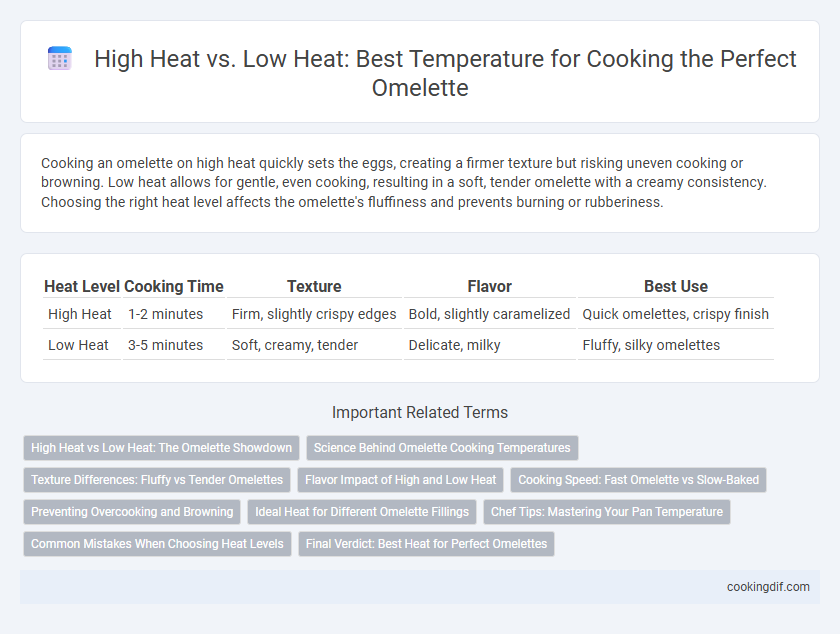Cooking an omelette on high heat quickly sets the eggs, creating a firmer texture but risking uneven cooking or browning. Low heat allows for gentle, even cooking, resulting in a soft, tender omelette with a creamy consistency. Choosing the right heat level affects the omelette's fluffiness and prevents burning or rubberiness.
Table of Comparison
| Heat Level | Cooking Time | Texture | Flavor | Best Use |
|---|---|---|---|---|
| High Heat | 1-2 minutes | Firm, slightly crispy edges | Bold, slightly caramelized | Quick omelettes, crispy finish |
| Low Heat | 3-5 minutes | Soft, creamy, tender | Delicate, milky | Fluffy, silky omelettes |
High Heat vs Low Heat: The Omelette Showdown
Cooking an omelette on high heat results in faster cooking with a slightly crispy exterior but can lead to uneven texture and burnt spots. Low heat allows for gentle cooking, producing a tender, evenly cooked omelette with a fluffy interior and minimal browning. Chefs often prefer low heat for control and optimal texture, while high heat suits those prioritizing speed and a golden crust.
Science Behind Omelette Cooking Temperatures
Cooking an omelette at high heat causes rapid coagulation of egg proteins, creating a firmer texture and potential browning through the Maillard reaction. Low heat allows for a gentler cooking process, preserving moisture and yielding a creamier, tender omelette by preventing protein over-tightening. Optimal temperature control balances heat to achieve desired texture while avoiding tough or rubbery eggs.
Texture Differences: Fluffy vs Tender Omelettes
Cooking an omelette over high heat results in a fluffy texture due to rapid air expansion and quick protein coagulation, which creates light and airy pockets. Low heat produces a tender omelette by allowing gradual cooking that preserves moisture and prevents browning, yielding a smooth, delicate consistency. Understanding heat control is essential for tailoring omelette texture to personal preference, balancing fluffiness and tenderness.
Flavor Impact of High and Low Heat
Cooking an omelette over high heat creates a slightly crispy texture and caramelized edges, enhancing umami and depth of flavor through Maillard reaction. Low heat preserves the delicate, creamy texture and subtle flavors of eggs, preventing browning but yielding a tender, smooth omelette. Choosing the heat level allows control over flavor profiles, balancing richness and texture according to preference.
Cooking Speed: Fast Omelette vs Slow-Baked
High heat rapidly cooks an omelette, creating a firm exterior while maintaining a slightly runny interior, ideal for a fast, fluffy texture. Low heat allows the omelette to cook slowly and evenly, producing a tender, custard-like consistency with enhanced flavor depth. Choosing high heat suits quick meals, whereas low heat is preferred for a delicate, slow-baked omelette experience.
Preventing Overcooking and Browning
Cooking an omelette over low heat prevents overcooking by allowing the eggs to cook gently and evenly, preserving a tender texture without browning. High heat causes rapid cooking, often resulting in browned, crispy edges and a rubbery interior due to uneven temperature distribution. Optimal control of heat influences the omelette's appearance and taste by minimizing excessive browning and maintaining moisture.
Ideal Heat for Different Omelette Fillings
High heat produces a quick, browned exterior ideal for simple, thin omelettes with delicate fillings like herbs and cheese. Low heat offers gentle cooking that prevents overbrowning and allows thorough heating of bulkier fillings such as vegetables and meats. Adjusting heat according to filling density ensures even cooking, optimal texture, and enhanced flavor in every omelette.
Chef Tips: Mastering Your Pan Temperature
Cooking an omelette over high heat ensures quick cooking and browning but risks burning and uneven texture, while low heat promotes gentle cooking and a tender, creamy interior. Chef tips emphasize preheating the pan to medium-low, using non-stick cookware for even heat distribution, and controlling temperature to avoid rubbery eggs. Mastering pan temperature enhances flavor, texture, and visual appeal for a perfectly cooked omelette every time.
Common Mistakes When Choosing Heat Levels
Cooking an omelette on high heat often leads to burnt edges and an undercooked center, resulting in an uneven texture that diminishes flavor. Using low heat prevents browning and causes the omelette to cook too slowly, producing a rubbery, dense consistency. Optimal heat control involves medium heat, allowing the eggs to set gently while maintaining a fluffy, tender texture without overcooking or burning.
Final Verdict: Best Heat for Perfect Omelettes
Cooking an omelette on medium heat provides the ideal balance, ensuring the eggs cook evenly without burning or drying out. High heat risks overcooking the exterior while leaving the inside underdone, creating a tough texture. Low heat extends cooking time, leading to rubbery results, making medium heat the best choice for a tender, fluffy omelette.
High heat vs Low heat for omelette cooking Infographic

 cookingdif.com
cookingdif.com